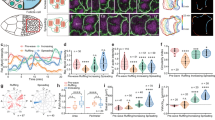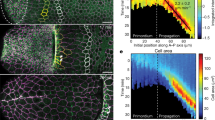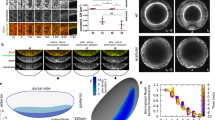Abstract
Mitotic cells assume a spherical shape by increasing their surface tension and osmotic pressure by extensively reorganizing their interphase actin cytoskeleton into a cortical meshwork and their microtubules into the mitotic spindle1,2. Mitotic entry is known to interfere with tissue morphogenetic events that require cell-shape changes controlled by the interphase cytoskeleton, such as apical constriction3,4,5. However, here we show that mitosis plays an active role in the epithelial invagination of the Drosophila melanogaster tracheal placode. Invagination begins with a slow phase under the control of epidermal growth factor receptor (EGFR) signalling; in this process, the central apically constricted cells, which are surrounded by intercalating cells6,7, form a shallow pit. This slow phase is followed by a fast phase, in which the pit is rapidly depressed, accompanied by mitotic entry, which leads to the internalization of all the cells in the placode. We found that mitotic cell rounding, but not cell division, of the central cells in the placode is required to accelerate invagination, in conjunction with EGFR-induced myosin II contractility in the surrounding cells. We propose that mitotic cell rounding causes the epithelium to buckle under pressure and acts as a switch for morphogenetic transition at the appropriate time.
This is a preview of subscription content, access via your institution
Access options
Subscribe to this journal
Receive 51 print issues and online access
$199.00 per year
only $3.90 per issue
Buy this article
- Purchase on Springer Link
- Instant access to full article PDF
Prices may be subject to local taxes which are calculated during checkout




Similar content being viewed by others
References
Théry, M. & Bornens, M. Get round and stiff for mitosis. HFSP J. 2, 65–71 (2008)
Stewart, M. P. et al. Hydrostatic pressure and the actomyosin cortex drive mitotic cell rounding. Nature 469, 226–230 (2011)
Großhans, J. & Wieschaus, E. A genetic link between morphogenesis and cell division during formation of the ventral furrow in Drosophila . Cell 101, 523–531 (2000)
Mata, J., Curado, S., Ephrussi, A. & Rørth, P. Tribbles coordinates mitosis and morphogenesis in Drosophila by regulating String/CDC25 proteolysis. Cell 101, 511–522 (2000)
Seher, T. C. & Leptin, M. Tribbles, a cell-cycle brake that coordinates proliferation and morphogenesis during Drosophila gastrulation. Curr. Biol. 10, 623–629 (2000)
Brodu, V. & Casanova, J. The RhoGAP crossveinless-c links trachealess and EGFR signaling to cell shape remodeling in Drosophila tracheal invagination. Genes Dev. 20, 1817–1828 (2006)
Nishimura, M., Inoue, Y. & Hayashi, S. A wave of EGFR signaling determines cell alignment and intercalation in the Drosophila tracheal placode. Development 134, 4273–4282 (2007)
Lecuit, T. & Lenne, P.-F. Cell surface mechanics and the control of cell shape, tissue patterns and morphogenesis. Nature Rev. Mol. Cell Biol. 8, 633–644 (2007)
Sawyer, J. M. et al. Apical constriction: a cell shape change that can drive morphogenesis. Dev. Biol. 341, 5–19 (2010)
Escudero, L. M., Bischoff, M. & Freeman, M. Myosin II regulates complex cellular arrangement and epithelial architecture in Drosophila . Dev. Cell 13, 717–729 (2007)
Corrigall, D., Walther, R. F., Rodriguez, L., Fichelson, P. & Pichaud, F. Hedgehog signaling is a principal inducer of Myosin-II-driven cell ingression in Drosophila epithelia. Dev. Cell 13, 730–742 (2007)
Vincent, A., Blankenship, J. T. & Wieschaus, E. Integration of the head and trunk segmentation systems controls cephalic furrow formation in Drosophila . Development 124, 3747–3754 (1997)
Wang, Y.-C., Khan, Z., Kaschube, M. & Wieschaus, E. F. Differential positioning of adherens junctions is associated with initiation of epithelial folding. Nature 484, 390–393 (2012)
Ghabrial, A., Luschnig, S., Metzstein, M. M. & Krasnow, M. A. Branching morphogenesis of the Drosophila tracheal system. Annu. Rev. Cell Dev. Biol. 19, 623–647 (2003)
Oda, H. & Tsukita, S. Real-time imaging of cell-cell adherens junctions reveals that Drosophila mesoderm invagination begins with two phases of apical constriction of cells. J. Cell Sci. 114, 493–501 (2001)
Campos-Ortega, J. A. & Hartenstein, V. The Embryonic Development of Drosophila melanogaster (Springer, 1997)
Lehner, C. F. & O’Farrell, P. H. Expression and function of Drosophila cyclin a during embryonic cell cycle progression. Cell 56, 957–968 (1989)
Garner, M., van Kreeveld, S. & Su, T. T. mei-41 and bub1 block mitosis at two distinct steps in response to incomplete DNA replication in Drosophila embryos. Curr. Biol. 11, 1595–1599 (2001)
Klämbt, C., Glazer, L. & Shilo, B. Z. breathless, a Drosophila FGF receptor homolog, is essential for migration of tracheal and specific midline glial cells. Genes Dev. 6, 1668–1678 (1992)
Sutherland, D., Samakovlis, C. & Krasnow, M. A. branchless encodes a Drosophila FGF homolog that controls tracheal cell migration and the pattern of branching. Cell 87, 1091–1101 (1996)
Baker, J. & Garrod, D. Epithelial cells retain junctions during mitosis. J. Cell Sci. 104, 415–425 (1993)
Meyer, E. J., Ikmi, A. & Gibson, M. C. Interkinetic nuclear migration is a broadly conserved feature of cell division in pseudostratified epithelia. Curr. Biol. 21, 485–491 (2011)
Bunch, T. A. et al. Characterization of mutant alleles of myospheroid, the gene encoding the β subunit of the Drosophila PS integrins. Genetics 132, 519–528 (1992)
Leptin, M. & Grunewald, B. Cell shape changes during gastrulation in Drosophila . Development 110, 73–84 (1990)
Martin, A. C., Kaschube, M. & Wieschaus, E. F. Pulsed contractions of an actin–myosin network drive apical constriction. Nature 457, 495–499 (2009)
Martin, A. C., Gelbart, M., Fernandez-Gonzalez, R., Kaschube, M. & Wieschaus, E. F. Integration of contractile forces during tissue invagination. J. Cell Biol. 188, 735–749 (2010)
Kato, K. & Hayashi, S. Practical guide of live imaging for developmental biologists. Dev. Growth Differ. 50, 381–390 (2008)
Haruta, T., Warrior, R., Yonemura, S. & Oda, H. The proximal half of the Drosophila E-cadherin extracellular region is dispensable for many cadherin-dependent events but required for ventral furrow formation. Genes Cells 15, 193–208 (2010)
Pandey, R., Heidmann, S. & Lehner, C. F. Epithelial re-organization and dynamics of progression through mitosis in Drosophila separase complex mutants. J. Cell Sci. 118, 733–742 (2005)
Wirtz-Peitz, F., Nishimura, T. & Knoblich, J. A. Linking cell cycle to asymmetric division: Aurora-A phosphorylates the par complex to regulate numb localization. Cell 135, 161–173 (2008)
Kakihara, K., Shinmyozu, K., Kato, K., Wada, H. & Hayashi, S. Conversion of plasma membrane topology during epithelial tube connection requires Arf-like 3 small GTPase in Drosophila . Mech. Dev. 125, 325–336 (2008)
Hayashi, S. & Yamaguchi, M. Kinase-independent activity of Cdc2/Cyclin A prevents the S phase in the Drosophila cell cycle. Genes Cells 4, 111–122 (1999)
Ohshiro, T. & Saigo, K. Transcriptional regulation of breathless FGF receptor gene by binding of TRACHEALESS/dARNT heterodimers to three central midline elements in Drosophila developing trachea. Development 124, 3975–3986 (1997)
Halfon, M. S. et al. New fluorescent protein reporters for use with the Drosophila Gal4 expression system and for vital detection of balancer chromosomes. Genesis 34, 135–138 (2002)
Chou, T. B. & Perrimon, N. Use of a yeast site-specific recombinase to produce female germline chimeras in Drosophila . Genetics 131, 643–653 (1992)
Le, T. et al. A new family of Drosophila balancer chromosomes with a w− dfd-GMR yellow fluorescent protein marker. Genetics 174, 2255–2257 (2006)
Bischof, J., Maeda, R. K., Hediger, M., Karch, F. & Basler, K. An optimized transgenesis system for Drosophila using germ-line-specific ϕC31 integrases. Proc. Natl Acad. Sci. USA 104, 3312–3317 (2007)
Lee, H. S., Simon, J. A. & Lis, J. T. Structure and expression of ubiquitin genes of Drosophila melanogaster . Mol. Cell. Biol. 8, 4727–4735 (1988)
Sotillos, S., Espinosa-Vázquez, J. M., Foglia, F., Hu, N. & Hombría, J. C.-G. An efficient approach to isolate STAT regulated enhancers uncovers STAT92E fundamental role in Drosophila tracheal development. Dev. Biol. 340, 571–582 (2010)
Acknowledgements
We thank the Kyoto and Bloomington Drosophila Stock Centers, the Developmental Studies Hybridoma Bank, E. Wieschaus, H. Oda and T. Nishimura for fly stocks and antibodies; K. Kato and H. Wada for assistance with data analysis and experiments; G. Sheng, E. Kuranaga, K. Kato, T. Otani and B. Dong for comments on the manuscript; and members of the Hayashi, Nishimura and Kuranaga laboratories for discussions. This work was supported by Grant-in-Aid for Scientific Research on Innovative Areas (22111007 to S.H.); Grant-in-Aid for Young Scientists (B) (23770624 to T.K.) from The Ministry of Education, Culture, Sports, Science and Technology, Japan; and the RIKEN Special Postdoctoral Researcher Program (T.K.)
Author information
Authors and Affiliations
Contributions
T.K. and S.H. conceived the project and wrote the manuscript, and T.K. performed the experiments.
Corresponding author
Ethics declarations
Competing interests
The authors declare no competing financial interests.
Supplementary information
Supplementary Information
This file contains Supplementary Figures 1-11, Supplementary Notes and additional references. (PDF 10689 kb)
Invagination of the tracheal placode
An embryo expressing E-cad-GFP (green) and His-RFP (magenta) Scale bar, 10 μm. (Related to Fig. 1a-c). (MOV 3698 kb)
Mitosis in the tracheal pit
An embryo expressing membrane-GFP. Scale bar, 10 μm. (Related to Fig. 1d). (MOV 2471 kb)
Invagination in a Cyclin A mutant embryo
A CycA mutant embryo expressing E-cad-GFP (green) and His-RFP (magenta). Scale bar, 10 μm. (Related to Fig. 2b). (MOV 2356 kb)
Invagination in a CycA bnl double mutant embryo
A CycA bnl double-mutant embryo expressing E-cad-GFP (green) and His-RFP (magenta) Scale bar, 10 μm. (Related to Fig. 2c). (MOV 2169 kb)
Invagination in a colchicine-treated embryo
A colchicine-treated embryo expressing E-cad-GFP (green) and His-RFP (magenta) Scale bar, 10 μm. (Related to Fig. 3). (MOV 3947 kb)
Invagination in a rho bnl double-mutant embryo
A rho bnl double-mutant embryo expressing Par-6-GFP (green) and His-RFP (magenta) Scale bar, 10 μm. (Related to Fig. 4e-h). (MOV 4456 kb)
Laser ablation of a non-tracheal cell
Laser ablation at the medial region of the apical surface of a surrounding cell. E-cad-GFP (green) and Myosin-mCherry (magenta). xy-view is the projection view of z2-6. Scale bar, 10 μm. (Related to Supplementary Fig. 9d-g). (MOV 524 kb)
Laser ablation of a tracheal cell at the apical-surface level
Laser ablation at the medial region of a central cell at the apical-surface level. E-cad-GFP (green) and Myosin-mCherry (magenta). xy-view is the projection view of z3-6. Scale bar, 10 μm. (Related to Supplementary Fig. 9h-j). (MOV 457 kb)
Laser ablation of a tracheal cell at the adherens junction level
Laser ablation at the medial region of a central cell at the adherens junction level. E-cad-GFP (green) and Myosin-mCherry (magenta). xy-view is the projection view of z3-6. Scale bar, 10 μm. (Related to Supplementary Fig. 9k-m). (MOV 474 kb)
Invagination in a rho CycA bnl triple mutant embryo
A rho CycA bnl triple-mutant embryo expressing Par-6-GFP (green) and His-RFP (magenta) Scale bar, 10 μm. (Related to Fig. 4i-l). (MOV 2506 kb)
Invagination in a rho CycA double mutant embryo
A rho CycA double-mutant embryo expressing Par-6-GFP (green) and His-RFP (magenta) Scale bar, 10 μm. (Related to Fig. S10i-l). (MOV 2286 kb)
Rights and permissions
About this article
Cite this article
Kondo, T., Hayashi, S. Mitotic cell rounding accelerates epithelial invagination. Nature 494, 125–129 (2013). https://doi.org/10.1038/nature11792
Received:
Accepted:
Published:
Issue Date:
DOI: https://doi.org/10.1038/nature11792
This article is cited by
-
Anillin governs mitotic rounding during early epidermal development
BMC Biology (2022)
-
ASPP2 maintains the integrity of mechanically stressed pseudostratified epithelia during morphogenesis
Nature Communications (2022)
-
Roughness and dynamics of proliferating cell fronts as a probe of cell–cell interactions
Scientific Reports (2021)
-
Coupled cycling and regulation of metazoan morphogenesis
Cell Division (2020)
-
Unraveling spatial cellular pattern by computational tissue shuffling
Communications Biology (2020)
Comments
By submitting a comment you agree to abide by our Terms and Community Guidelines. If you find something abusive or that does not comply with our terms or guidelines please flag it as inappropriate.



